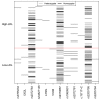The N342S MYLIP polymorphism is associated with high total cholesterol and increased LDL receptor degradation in humans
- PMID: 21765216
- PMCID: PMC3148733
- DOI: 10.1172/JCI45504
The N342S MYLIP polymorphism is associated with high total cholesterol and increased LDL receptor degradation in humans
Abstract
Atherosclerotic cardiovascular disease (ASCVD) affects more than 1 in 3 American adults. Hypercholesterolemia is a major treatable risk factor for ASCVD, yet many individuals fail to reach target levels of LDL-cholesterol (LDL-C) through the use of statins and lifestyle changes. The E3 ubiquitin ligase myosin regulatory light chain-interacting protein (MYLIP; also known as IDOL) is a recently identified regulator of the LDL receptor (LDLR) pathway. Genome-wide association studies (GWASs) in populations of mixed European descent have identified noncoding variants in the MYLIP region as being associated with LDL-C levels, but no underlying functional variants were pinpointed. In order to fine-map actual susceptibility variants, we studied a population demographically distinct from the discovery population to ensure a different pattern of linkage disequilibrium. Our analysis revealed that in a Mexican population, the nonsynonymous SNP rs9370867, which encodes the N342S amino acid substitution, is an underlying functional variant that was associated with high total cholesterol and accounted for one of the previous significant GWAS signals. Functional characterization showed that the Asn-encoding allele was associated with more potent LDLR degradation and decreased LDL uptake. Mutagenesis of residue 342 failed to affect intrinsic MYLIP E3 ligase activity, but it was critical for LDLR targeting. Our findings suggest that modulation of MYLIP activity can affect LDL-C levels and that pharmacologic inhibition of MYLIP activity might be a useful strategy in the treatment of dyslipidemia and ASCVD.
Figures




Similar articles
-
MYLIP p.N342S polymorphism is not associated with lipid profile in the Brazilian population.Lipids Health Dis. 2012 Jun 28;11:83. doi: 10.1186/1476-511X-11-83. Lipids Health Dis. 2012. PMID: 22741812 Free PMC article.
-
Fibroblast growth factor-21 (FGF21) regulates low-density lipoprotein receptor (LDLR) levels in cells via the E3-ubiquitin ligase Mylip/Idol and the Canopy2 (Cnpy2)/Mylip-interacting saposin-like protein (Msap).J Biol Chem. 2012 Apr 13;287(16):12602-11. doi: 10.1074/jbc.M112.341248. Epub 2012 Feb 29. J Biol Chem. 2012. PMID: 22378787 Free PMC article.
-
IDOL, inducible degrader of low-density lipoprotein receptor, serves as a potential therapeutic target for dyslipidemia.Med Hypotheses. 2016 Jan;86:138-42. doi: 10.1016/j.mehy.2015.11.010. Epub 2015 Nov 14. Med Hypotheses. 2016. PMID: 26601593
-
The E3 ubiquitin ligase inducible degrader of the LDL receptor/myosin light chain interacting protein in health and disease.Curr Opin Lipidol. 2019 Jun;30(3):192-197. doi: 10.1097/MOL.0000000000000593. Curr Opin Lipidol. 2019. PMID: 30896554 Review.
-
Post-transcriptional regulation of lipoprotein receptors by the E3-ubiquitin ligase inducible degrader of the low-density lipoprotein receptor.Curr Opin Lipidol. 2012 Jun;23(3):213-219. doi: 10.1097/MOL.0b013e3283532947. Curr Opin Lipidol. 2012. PMID: 22510808 Review.
Cited by
-
MYLIP p.N342S polymorphism is not associated with lipid profile in the Brazilian population.Lipids Health Dis. 2012 Jun 28;11:83. doi: 10.1186/1476-511X-11-83. Lipids Health Dis. 2012. PMID: 22741812 Free PMC article.
-
The MYLIP p.N342S polymorphism is associated with response to lipid-lowering therapy in Brazilian patients with familial hypercholesterolemia.Pharmacogenet Genomics. 2014 Nov;24(11):548-55. doi: 10.1097/FPC.0000000000000089. Pharmacogenet Genomics. 2014. PMID: 25171759 Free PMC article.
-
Liver X receptors in lipid metabolism: opportunities for drug discovery.Nat Rev Drug Discov. 2014 Jun;13(6):433-44. doi: 10.1038/nrd4280. Epub 2014 May 16. Nat Rev Drug Discov. 2014. PMID: 24833295 Review.
-
miR-19b promotes breast cancer metastasis through targeting MYLIP and its related cell adhesion molecules.Oncotarget. 2017 Jul 17;8(38):64330-64343. doi: 10.18632/oncotarget.19278. eCollection 2017 Sep 8. Oncotarget. 2017. PMID: 28969074 Free PMC article.
-
Genetic determinants of inherited susceptibility to hypercholesterolemia - a comprehensive literature review.Lipids Health Dis. 2017 Jun 2;16(1):103. doi: 10.1186/s12944-017-0488-4. Lipids Health Dis. 2017. PMID: 28577571 Free PMC article. Review.
References
Publication types
MeSH terms
Substances
Associated data
- Actions

